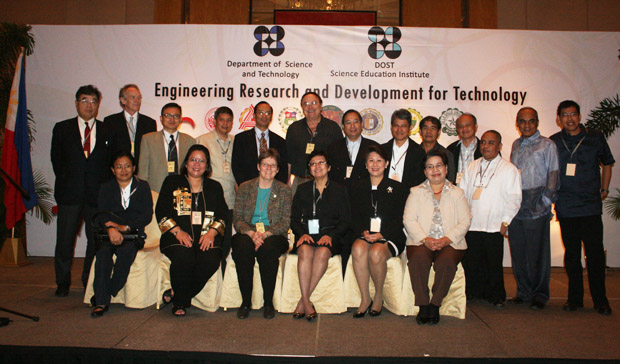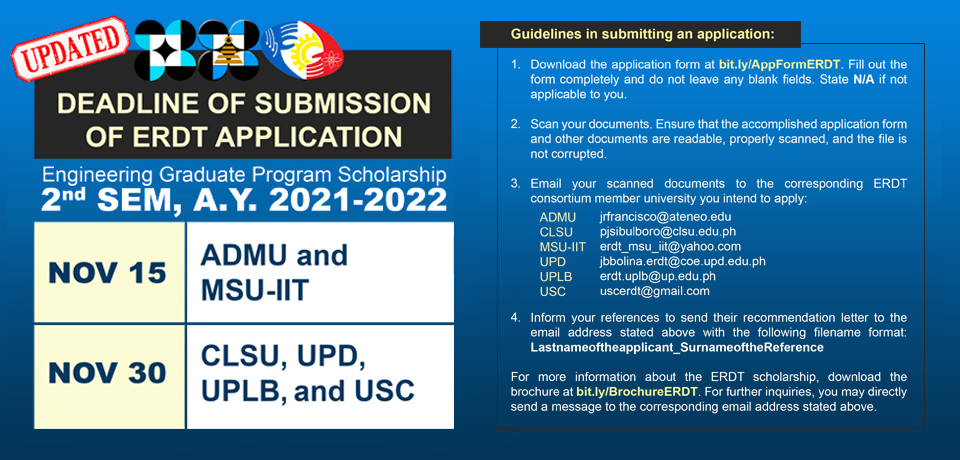4th ERDT Conference
R&D ROADMAP OF THE PHILIPPINES
TACKLED IN 4th ERDT CONFERENCE*
Celeste Ann Castillo Llaneta
Scientific and engineering research and development (R&D) done within the confines of the university laboratory is well and good. But for technology to really have an impact, it has to be brought out to the “real world”—to the market and ultimately to the consumers themselves.
For researchers who are ready to bring the fruits of their labor to the greater arena, a panel of experts from abroad give the following advice: 1.) Professional knowledge must be balanced with a sense of what is practical and an understanding of society’s needs; 2.) Defining the mission of R&D and charting and R&D roadmap will serve as guide to success; 3.) Designs should be both innovation-driven and sustainable; 4.) Linking up with the industry, private sector, and government is important; 5.) Focus should be a fast-growing field such as biotechnology; and 6.) Research should be truly interdisciplinary.
These were the subjects of the Engineering Research and Development for Technology’s (ERDT) fourth conference held on February 19, 2010 at the Sofitel Philippine Plaza Manila, CCP Complex, Roxas Blvd., Pasay City, with the theme “Charting the R&D Roadmap of the Philippines.”
Held in partnership with the Department of Science and Technology (DOST) and the DOST-Science Education Institute, the conference was attended by students, faculty members, researchers, and administrators from the eight consortium universities under the nationwide ERDT Project, namely; Ateneo de Manila University (ADMU), Central Luzon State University (CLSU), De La Salle University (DLSU), Mapua Institute of Technology (MIT), Mindanao State University-Iligan Institute of Technology (MSU-IIT), University of San Carlos (USC), UP Los Baños (UPLB), and UP Diliman (UPD), the latter having spearheaded the consortium in 2007.
The six speakers, who discussed the ways academe could bring the results of engineering R&D to end-users, including government, industry, and ordinary consumers, were: Dr. Yozo Fujino, Professor of Civil Engineering at the University of Tokyo, Japan; Dr. Gavriel Salvendy, Professor of Industrial Engineering of Tsinghua University, China; Dr. Joel L. Cuello, Professor of Biosystems Engineering at the University of Arizona, US; Dr. David Ian Bishop, Professor of Geomatics, University of Melbourne, Australia; Dr. Chang-Ho Park, Professor of Chemical Engineering at Kyung Hee University, South Korea; and Dr. Nina Ossanna, Director of the Business Development and Strategic Planning, BIO5 Institute of the University of Arizona.

The members of ERDT Steering Committee pose with guest speakers
The importance of the various discipline and sectors working together on a project was emphasized by Dr. Fujino. He also stressed the need for students to not only have professional knowledge but also a sense of practicability, as well as an understanding of society and its needs, which can be attained when students apply their research in the field.
Dr. Salvendy advised to concentrate on research the yields economic benefits in the shortest time possible, on research that would improve research, and on research that would earn prestige in the international scene.
Dr. Cuello emphasized the primacy of engineering education—particularly an innovation-driven and sustainability-centered engineering design—in a competitive and interconnected global economy. He enumerated seven laws of sustainability, as exemplified by the rice terraces of Banaue, to wit: the laws of availability, harmony, knowledge, re-use, symbiosis, peers, and community.
The Australian Cooperative Research Centre (CRC) Program was introduced by Dr. Bishop as a possible model for the Philippines. This program is oriented toward research utilization and commercialization, and actively supports end-user-driven partnerships between researchers and the industry.
Dr. Park encouraged engineers to focus, despite the world moving toward biotechnology economy, on new business opportunities in biopharmaceuticals, energy/biochemical materials, environmental remediation, agriculture and food products, and bio-resources. While Dr. Ossanna underscored true interdisciplinary research among the various university departments and making technology transfer easier for researchers and research teams.
Finally, DOST Secretary Estrella F. Alabastro expressed the hope that venture capitalists get more involved in the difficult and critical stage of incubating R&D-based technologies for transition to the commercial stage. She cited the Open Technology Business Incubator at the UP Science and Technology Park along CP Garcia Ave., UPD, Quezon City—launched in partnership with the DOST, the Philippine Economic Zone, the Advanced Science and Technology Institute, and UP—as an example of collaboration between government and private companies.
The 4th ERDT Conference was organized by the ERDT Steering Committee, led by UPD College of Engineering Dean Rowena Cristina L. Guevara. Project leaders for their respective universities are: Dr. Fabian M. Dayrit for ADMU; Dr. Ireneo C. Agulto for CLSU; Dr. Pag-asa D. Gaspillo for DLSU; Dr. Jonathan L. Salvacion for MIT; Dr. Feliciano C. Alagao for MSU-IIT; Dr. Nicanor S. Buenconsejo for USC; Dr. Arnold R. Elepaño for UPLB; and Dr. Norbert S. Que for UPD.
*4th ERDT Conference “Post Graduate Multidisciplinary Approach to Solving Philippine Problems”, February 19, 2010 Sofitel Philippine Plaza, Manila, Philippines


